January 19, 2023 (Updated April 3rd, 2024)
Xmind vs MindManager vs Ayoa: Definitive Comparison [2023]
![Ayoa | Xmind vs MindManager vs Ayoa: Definitive Comparison [2023]](https://y9c2m8e4.rocketcdn.me/wp-content/uploads/2023/01/xmind_manager_ayoa.jpg)
You can create mind maps with both Xmind and MindManager…
Though subtle workflow differences make them better suited for different audiences and use cases.
In fact, after using the tools I realized that students, teachers, consultants, and business executives won’t find either Xmind or MindManager useful for enhancing individual creativity and productivity. Which is why I’ve added Ayoa to the comparison: it picks up where both Xmind and MindManager fall short.
Besides comparing their mind mapping, whiteboarding, and task boarding capabilities, I’ll also cover:
-
Pricing
-
Templates
-
Integrations
-
Collaboration
Let’s see who wins: Xmind vs MindManager vs Ayoa.
Comparison Summary: Xmind vs. MindManager vs. Ayoa
Xmind is ideal for lightweight note-taking, small personal projects, and startups that want to create simple, public-facing mind maps for sales or PR. MindManager is best for teams that want to create visual systems and SOPs. And Ayoa is best for students, teachers, executives, and business consultants who want to enhance creativity, problem-solving, and productivity.

|

|

|
||
|---|---|---|---|---|
| Price | ||||
| Price |
Offers a free plan. There’s only one paid plan at $6/month. |
30-day free trial. Paid plans start at $100/year. Team plan is $170/year/user. |
Free 7-day trial. Mind mapping and task boarding tools cost $10/user/month each. Ayoa Ultimate is $13/user/month. |
|
| Mind mapping | ||||
| Mind mapping |
Minimal and clear interface that’s easy to navigate. Premade themes and 43 mind map layouts for “speed maps”. |
Highly customizable elements and 9 mind map layouts for “speed maps”. |
Smooth workflow, organic feel, easy to learn, 4 types of mind maps: speed, organic, radial, and capture maps. |
|
| AI | ||||
| AI |
Doesn’t have AI functionality |
Doesn’t have AI |
Ultimate version allows you to use AI to generate ideas and images |
|
| Project Management | ||||
| Project Management |
Add tags, labels, symbols, hyperlinks, and notes to topics. |
Everything Xmind can do + automatically turning the mind map into a Kanban board view. |
Everything MindManager can do + dedicated Gantt, Kanban, and Task Boards for advanced project management. |
|
| Whiteboard | ||||
| Whiteboard |
Doesn’t have a whiteboard or whiteboard-like functionality. |
Has a “free form” mind map for adding unconnected elements, images, and notes on board. |
Powerful whiteboard for drawing, adding text, notes, images, lists, flowcharts, and diagrams. |
|
| Templates | ||||
| Templates |
30 templates covering various use cases: to-do lists, schedules, website mockups, planners, etc. |
Offers lots of business-focused templates that feel a bit too similar. |
Templates from the world-renowned mind-mapping expert that mirror how the brain works. |
|
| Collaboration & presentation | ||||
| Collaboration & presentation |
Turn mind maps into slide decks, basic collaboration features, embed maps onto websites. |
Robust auto-presentation feature, team comments, but lacks publish sharing. |
Auto-presentation feature, internal messages and comments, password-protected sharing. |
|
| Integrations | ||||
| Integrations |
Doesn’t have integrations. |
Through Zapier, it integrates with up to 5000 tools:Asana, Trello, Google Docs, Microsoft Teams… |
Has 7 basic integrations with Dropbox, Google Drive, and Calendar. |
|
| Best for | ||||
| Best for | Startups that want to create simple, public-facing ming maps | Companies or teams that need to create visual systems and SOPs. | Enhancing creativity and productivity during work or study. | |
| Try free forever (no card required) |
Try free for 30 days (no card required) |
Try for 7 days (no card required) |
||
What is Xmind?
“Move fast and look cool”

Xmind was founded in 2006 in Hong Kong with the goal of inspiring people to become more innovative.
Since then, Xmind has stayed true to its goal by maintaining unmatched ease of use and a minimalistic user interface. It’s the easiest of the three tools to learn and master. Instead of filling your screen with features you may never use, Xmind gives the essentials: mind mapping, premade themes, and presentations. Xmind also has a powerful website embed feature and public sharing capabilities, making it ideal for creating sales decks and releasing public roadmaps as a startup.
Because Xmind doesn’t have any project management features, it’s ideal as a note-taking tool for smaller personal projects to create visual representations of their ideas and goals.
What Is MindManager?
“Building organizations”

MindManager began developing in 1994 by Michael Jetter, who wanted to create a versatile mind mapping tool that will replace pen and paper.
This led to MindManager becoming a powerful productivity tool that makes it easy to work as a team. Through Zapier, it has over 5000 integrations that help distribute information across multiple platforms. It looks and feels similar to Xmind, though it’s more feature-packed and has a more complex UI. Its mind maps can host flowcharts and turn into Kanban boards for project management, and the robust auto-presentation feature can create presentations on the spot.
With its steep pricing and lack of public sharing options, MindManager is best suited for larger organizations that need an efficient way to visually organize their SOPs, business processes, and documentation.
What Is Ayoa?
“Mind mapping for creative thinkers”
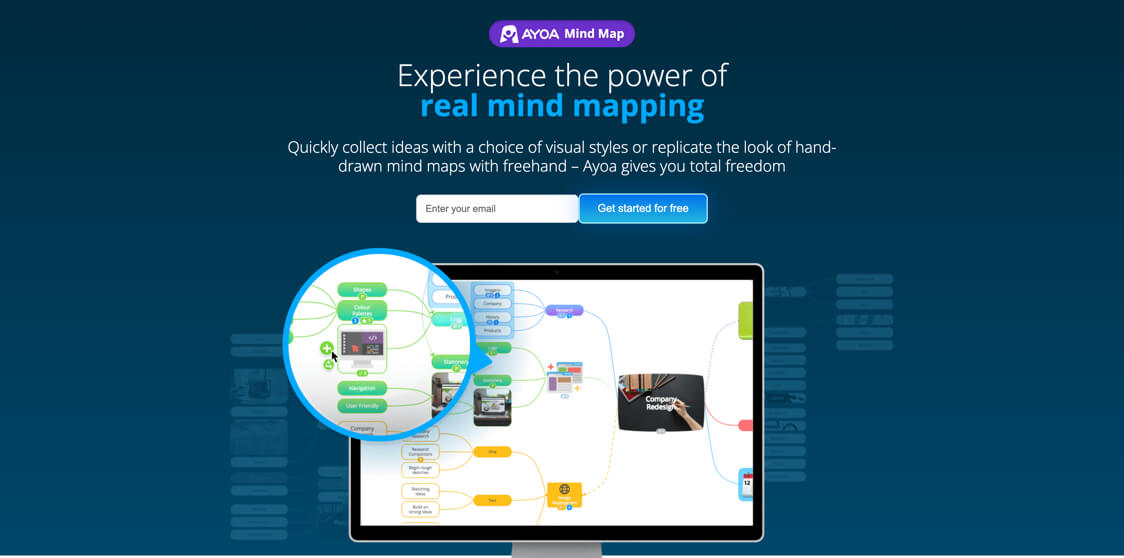
Ayoa was developed by Chris Griffith, the world’s leading mind mapping expert.
Ayoa mimics the natural thinking process through organic mind mapping, and it’s the only mind-mapping software with artificial intelligence as well as freehand mind mapping capabilities. Ayoa is the perfect blend of whiteboard, task management, and mind mapping tools. Unlike other tools in this review, it has a dedicated task board where you can set goals and deadlines, and collaborate with your teammates. Another exciting feature of Ayoa is its extensive collection of expertly designed templates for business strategy and personal planning. If you’d like to try them yourself, grab the 7-day trial (no card required) today.
Ayoa is the best mind mapping software for personal productivity and creative problem solving as well as project management for teams of up to ten people.
Xmind vs. MindManager vs. Ayoa: Mind Mapping
Ayoa produces the most visually appealing and creative mind maps, Xmind is simple and versatile, and MindManager is complex and customizable.

Ayoa’s has an easy-to-understand interface that promotes creativity, Xmind is extremely minimalistic, and MindManager feels slightly more complex.
Ayoa’s interface is easy to understand and doesn’t feel “business-like”. It uses an interface that avoids forcing “linear thinking” on users and therefore creates more of a creative thinking environment.
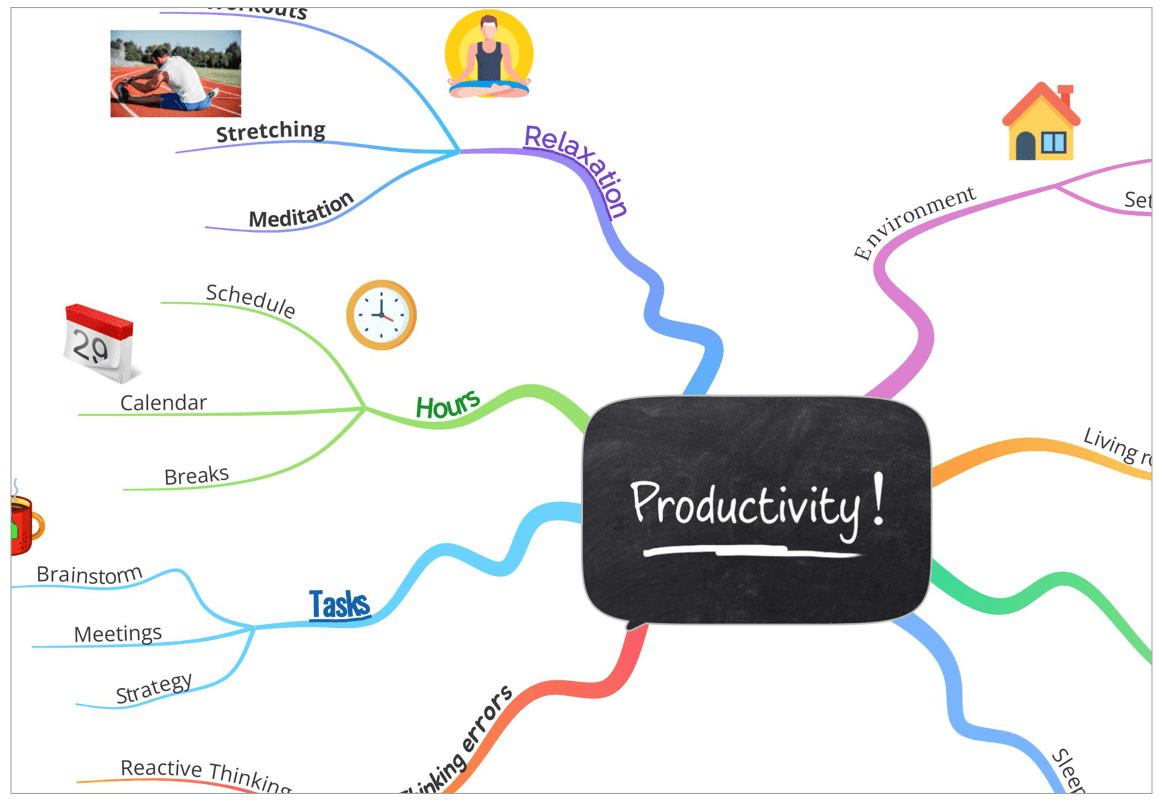
With a sleek, modern design, Xmind has one of the most minimalistic interfaces out of all mind mapping tools.

MindManager looks extremely similar to Xmind. The main difference is that it has more options and thus a more cluttered menu. Because of that, it has a steeper learning curve.

Xmind’s shortcut-based workflow is fast but takes some learning, Ayoa feels the most organic, and MindManager also has a shortcut-based workflow but supports mouse-based use as well.
Xmind took minimalism to the next level. The only way to add new topics to the mindmap is with shortcuts: ENTER to add a topic, and TAB to add a subtopic. It takes about 30 minutes to get used to, and once you’re well-versed you can create new mind maps almost at your normal typing pace.
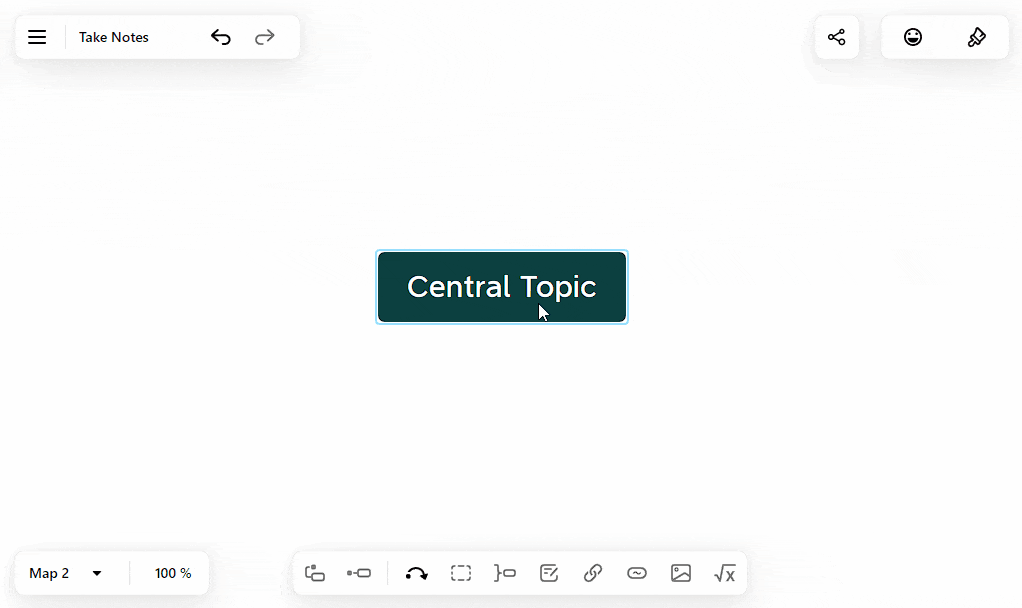
Ayoa also has all the same shortcuts as Xmind, but it also has large buttons for adding new topics, and a “freehand drawing” option for creating organic-looking relationship lines. This is one of Ayoa’s biggest strengths: the imperfect organic lines and shapes are easier to remember and recall, allowing you to quickly navigate through a mind map in your mind while giving a talk or performing a task.
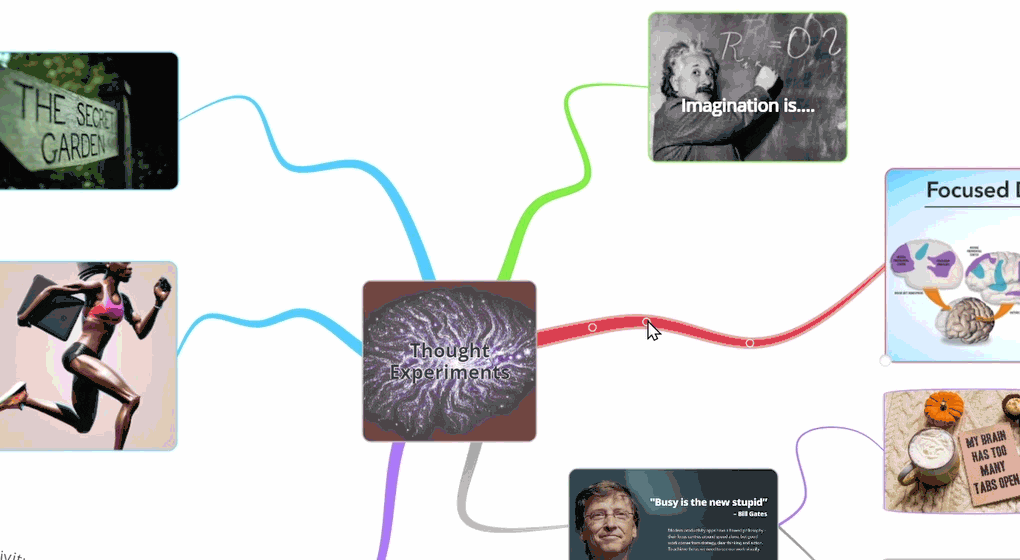
MindManager, on the other hand, has a more clear cut flow. Like Xmind, it supports keyboard shortcuts and it also has buttons to add topics with your mouse. The logic for moving, snapping, and aligning topics in different places feels more intuitive than Xmind, while the snappy animation makes it feel less organic than Ayoa.
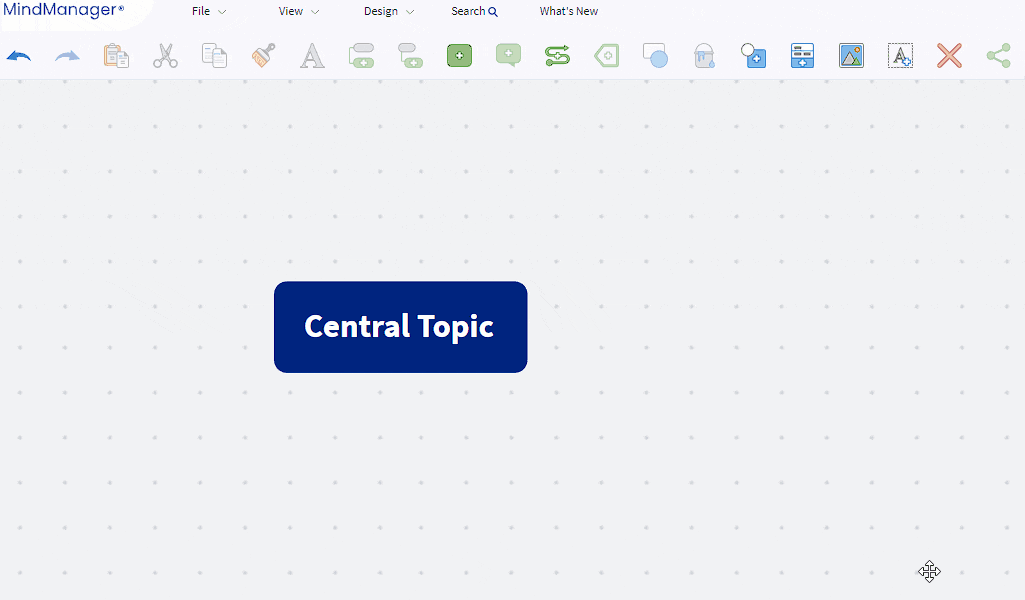
Xmind and MindManager are highly customizable with many premade themes, and Ayoa is fun and colorful by default.
Xmind has a ton of premade design templates that you can easily switch between while working. You’ll be able to find a theme for every vibe of your mind map.

MindManager comes with fewer designs out of the box, but its customization options are equally powerful as Xmind’s.
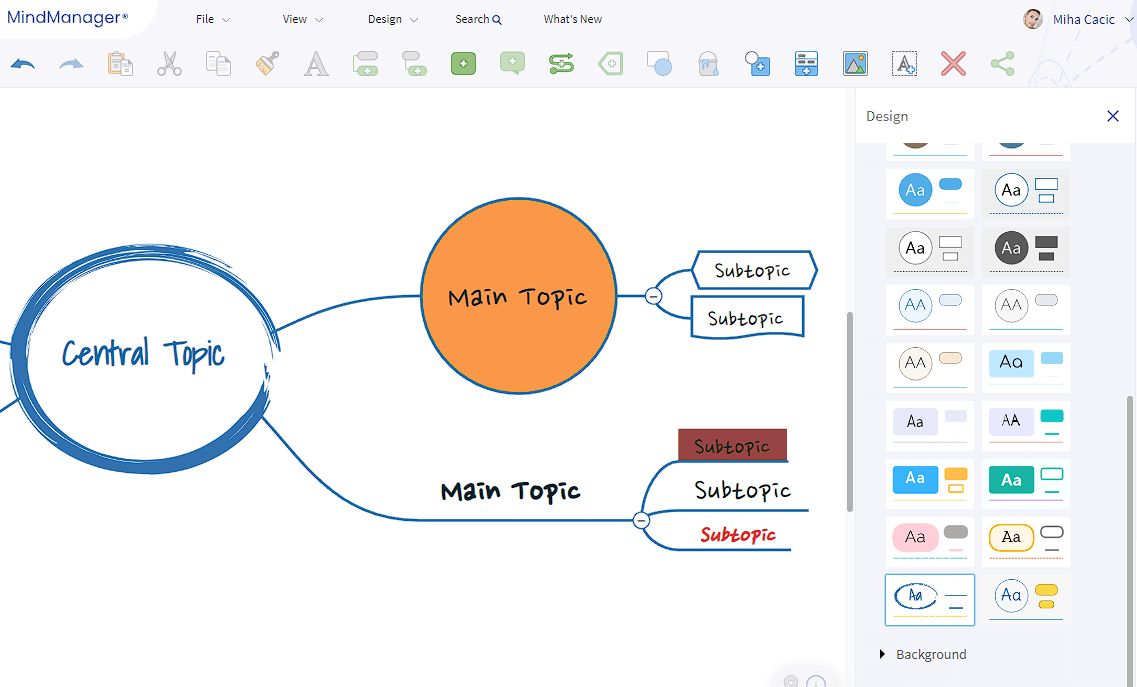
Although Ayoa is also fully customizable, unlike Xmind and MindManager, it doesn’t have premade themes. But Ayoa excels at adding and integrating images to mind maps.

Ayoa has 4 different types of mind maps, Xmind only has speed maps in 43 different layouts, and MindManager only has speed maps in 9 layouts.
Ayoa has four different mind maps, each one serving a different purpose:
-
Speed map: these are structured, easy-to-use maps for organizing your thoughts quickly.
-
Organic map: these are lively, highly customizable maps with curved branches for creating maps that you can easily memorize, recall, and visualize.
-
Capture map: for capturing ideas as soon as they enter your mind, perfect for brainstorming and convergent thinking
-
Radial map: pie-chart style map made for goal setting and visualizing the next steps in a project
In Ayoa, each one of these mind minds can be turned into one another; and every one has a slightly different workflow to better fit how your brain works.
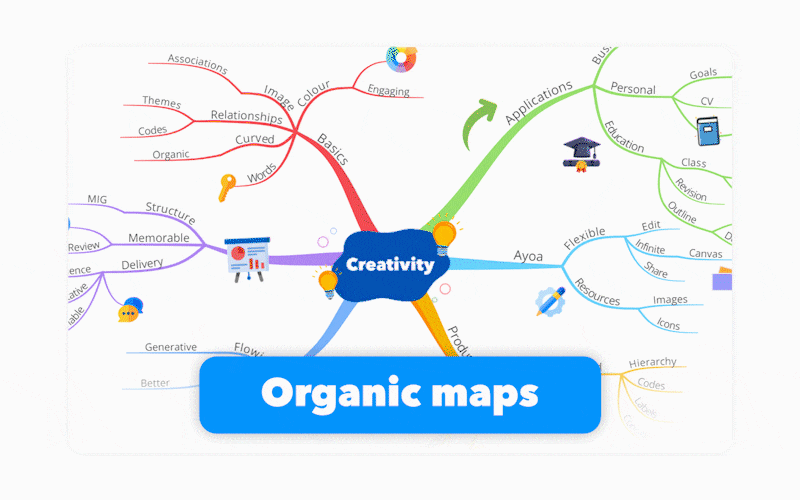
Although Xmind only has speed maps, you can use 43 different speed map layouts across 9 different categories:
-
1. Map
-
2. Logic chart
-
3. Brace map
-
4. Org chart
-
5. Tree chart
-
6. Timeline
-
7. Fishbone
-
8. Tree table
-
9. Matrix

Xmind vs. MindManager vs. Ayoa: Project Management
MindManager and Xmind do project management in their Mind Maps, while Ayoa has a dedicated project management tool suite.

Paired with its tags and labels, Xmind can be a decent personal to-do list.
Every topic in Xmind can be labeled… hyperlinked… or given a note. You can add your own images or use stickers available in Xmind for visual categorization… And you can add various tags, priorities, progress marks, and other symbols to categorize or track the progress of your tasks.

Overall Xmind has an extremely simple task management system for keeping track of activities on a broad level. It’s not ideal for serious project planning or management, as it lacks more in-depth annotations and time and progress tracking.
MindManager has a Kanban board integrated with the Mind Maps.
MindManager, similarly to Xmind, also has symbols, labels, notes, and hyperlinks for the elements on your Mind Map. But, unlike Xmind, these can be viewed in a Kanban view as well. Here, you can drag and drop elements to different lanes to change labels automatically and track your project progress that way.
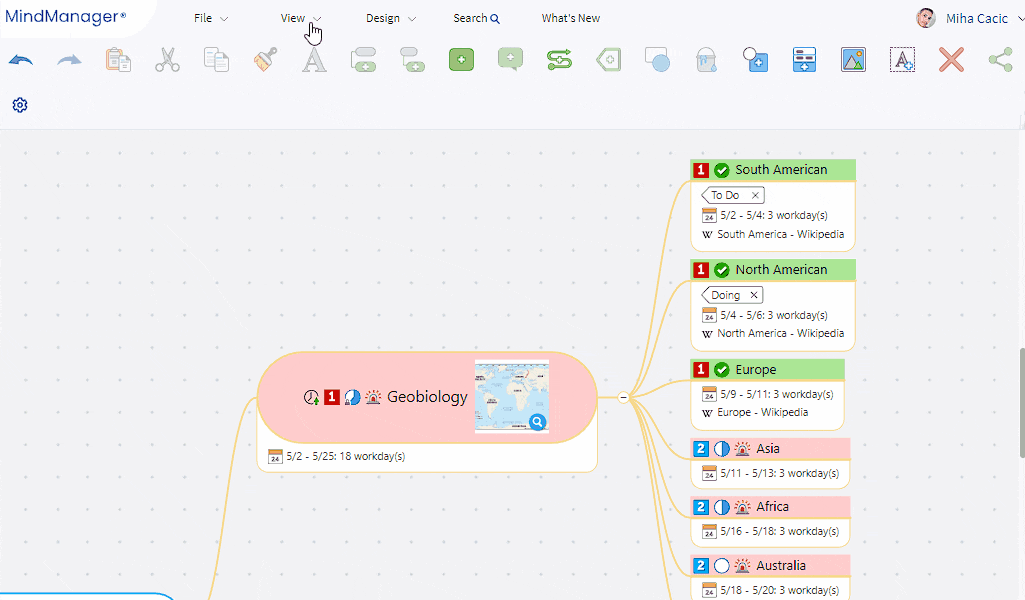
Ayoa can handle project management for teams of 1-10 people, thanks to its versatile Gantt, Kanban, and Task Boards.
Although you can interlink them, Ayoa has a dedicated workspace for Gantt, Kanban, and Task Boards that is separate from Mind Maps.
Here you can create tasks, update progress, set start & end dates, assign teammates, and add tags and reminders. Teammates can also comment, leave notes, attachments, and even checklists. And every task has a history of changes made by everyone on the team.
And the best part?
You can seamlessly change the view from Kanban, Gantt, or Task Board and back — to best fit your current needs — without having to commit to one management structure.
Ayoa Task board view:
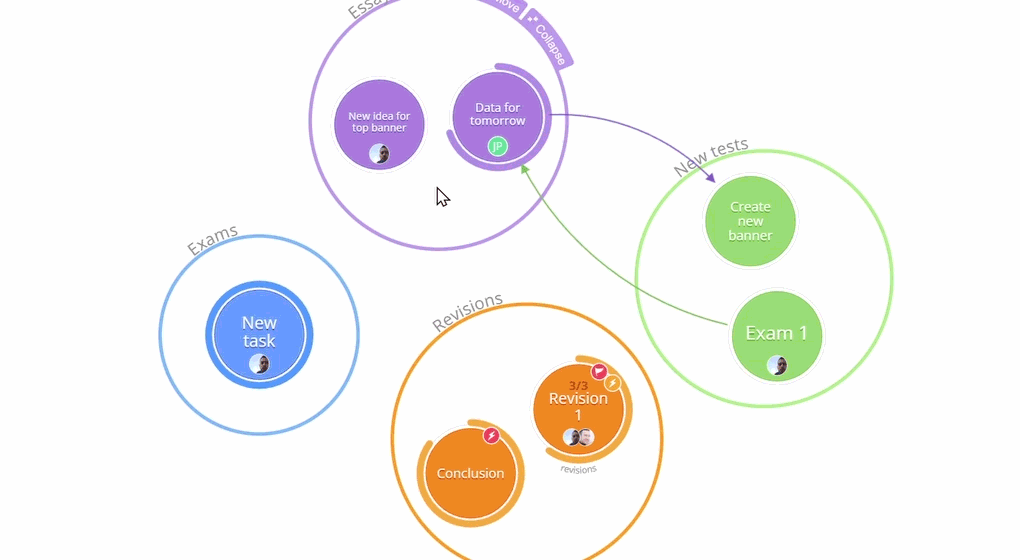
Ayoa Gantt timeline view:
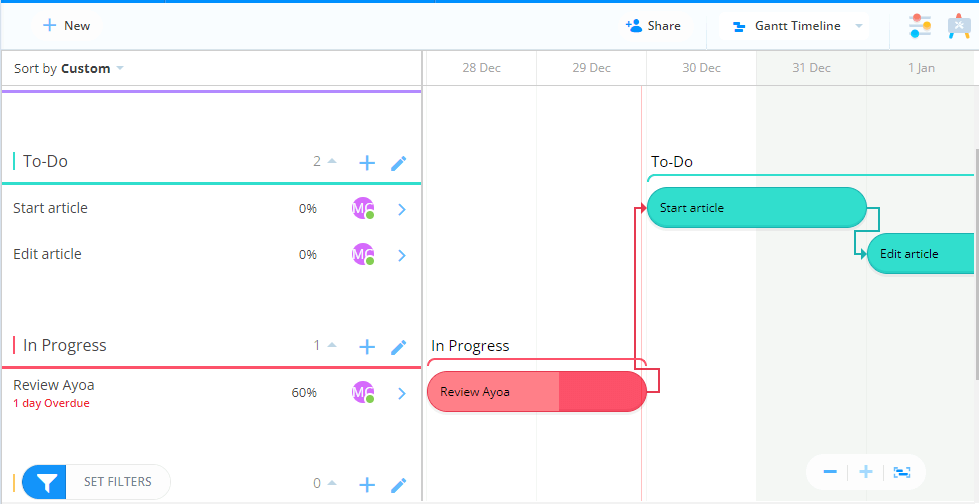
Ayoa Kanban board view:
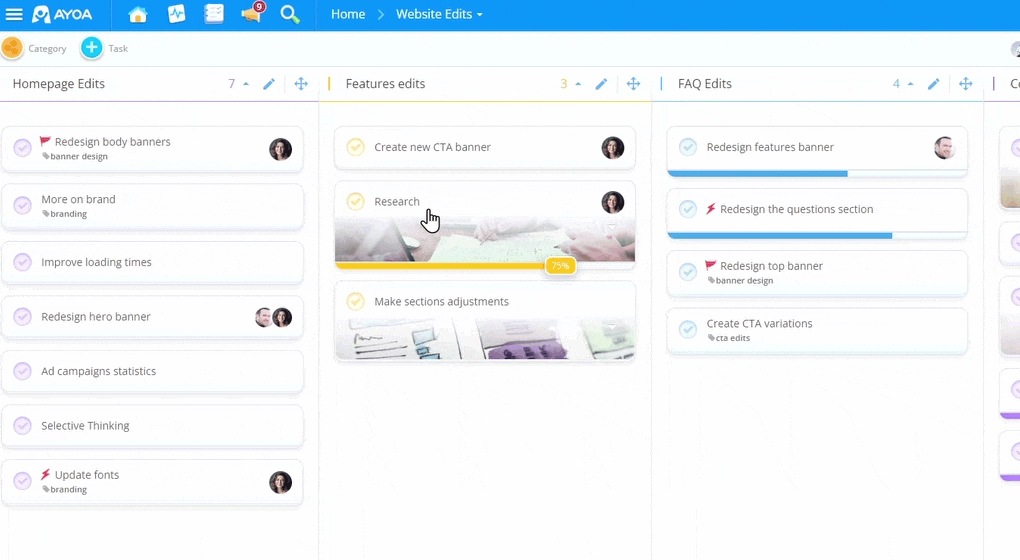
Although not as powerful as dedicated project management program, for managing your own projects or a team of 1-10 people Ayoa is an absolute delight.
Xmind vs. MindManager vs. Ayoa: Whiteboard
Xmind doesn’t have whiteboarding functionality, MindManager has “free form” mind maps, and Ayoa has a dedicated whiteboard tool.

MindManager has “free form” mind maps where you can add unconnected elements, images, and notes on the board.
While MindManager’s “free form” mind maps are not actually whiteboards, they can be used as such. Like on any mind map, you can add topics and notes and connect them manually with relationship lines. But without the drawing options, the workflow will feel restrictive.
Ayoa has a powerful whiteboard tool for brainstorming with the team.
Ayoa has powerful whiteboarding features like adding free-form text, notes, images, and lists. You can also draw diagrams, flowcharts, and even embed other boards. Despite all of these features, it remains easy to use, making it perfect for brainstorming ideas, taking notes during meetings, teaching lessons, and making first rough plans for various projects.

Xmind vs. MindManager vs. Ayoa: Templates
Ayoa templates were made by experts, Xmind has few but useful templates and MindManager templates focus on businesses only.

Xmind has 30 templates for various use cases.
Including shopping and to-do lists… class schedules and course syllabi… homepage mockups and company structures… even family trees and financial planners. Each of Xmind’s templates is unique and gives you a new perspective on how you can use Xmind. Their Libary is packed full of clip arts, markers, and icons for further personalization.

MindManager templates are focused solely on business use cases.
MindManager has a decent collection of business templates.

Ayoa templates were made by a mind mapping expert.
Ayoa has 121 templates on studying, productivity, innovation, business, and more. You get far more than just mind map templates. All were designed by the mind mapping expert Chris Griffiths. You can also find templates from Marshall Goldsmith in Ayoa, a best-selling author and leadership expert.

Xmind vs. MindManager vs. Ayoa: Collaboration & Presentation
MindManager is best for presenting to your teammates, Xmind for creating sales and PR, and Ayoa for 1-1 meetings.

If you have team plans, you can collaborate on the same document in real-time with all three tools.
Ayoa and Xmind let you password-protect your projects when sharing publicly.
With Ayoa and Xmind, you can share your mind maps with anyone: they don’t have to register or log in to view them. To protect your map from unwanted leaks, you can set a password or let it be seen only by people you’ve approved.

MindManager doesn’t have this feature, and you can only share your files with your teammates.
MindManager and Ayoa have automatic presentation creation, and Xmind works like a slide deck.
In Ayoa, unlike presentations in Powerpoint, this produces non-linear presentations. You can jump from Whiteboards to Mind maps during a presentation, and even jump to a specific branch on another mind map.
Here’s an example from Ayoa:
When it comes to presenting your mind map to a team, Ayoa and MindManager work in an identical way: the “auto present” option reveals different parts of the mind map in the same sequence you’ve put down the elements. You can also edit the order manually.
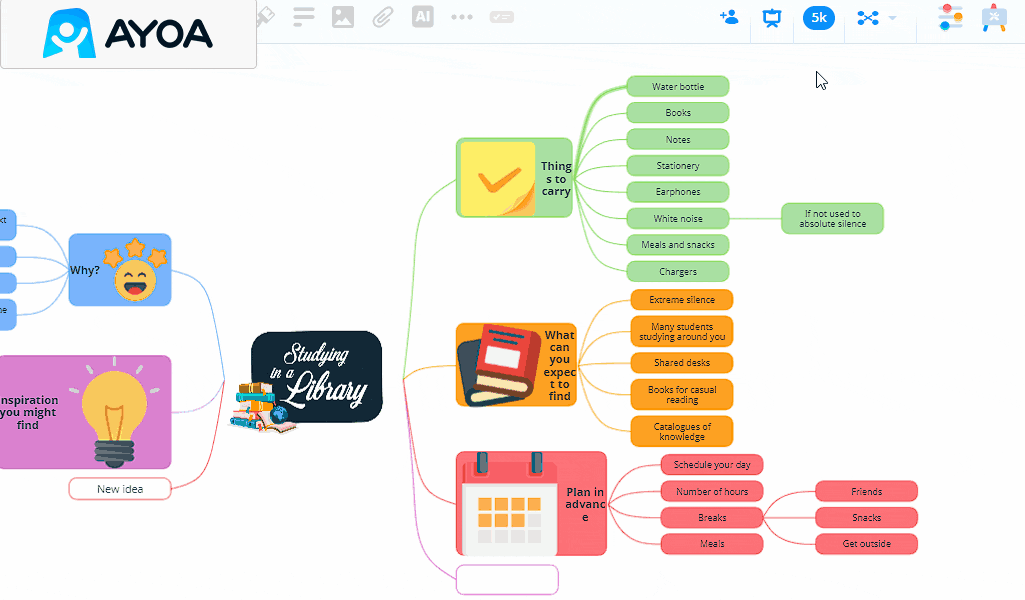
Xmind works slightly differently. Here, you are showing two screens: one is the presenting screen another is the controlling screen. The controlling screen is the mind map. When you click on one topic element, Xmind turns the topic, labels, and notes into a slide screen. It’s nifty for showing only the parts of your presentation that you want while helping you not get lost. Perfect for sales decks.
Xmind vs. MindManager vs. Ayoa: Integrations
Xmind doesn’t have integrations, Ayoa has 7 native integrations, and MindManager has over 5000 through Zapier.

Through Zapier, MindManager can connect to any popular software like Google Calendar, Gmail, Docs, Trello, and more.
MindManager’s Zapier integration is triggered only when you press the “Zap” button in the top corner of MindManager. It’s not automatable in the sense that you can set up triggers. It’s still a good way to sync your mind map across your tech stack: have MindManager as the central hub for everything project management related.

Ayoa covers the basics: Dropbox, Google Drive, and Calendar.
Ayoa integrations are meant for students, teachers, and consultants. This audience typically only needs storage (like Google Drive or Dropbox), and a calendar to manage their time. While not as extensive as MindManager’s, Ayoa integrations are native. Meaning, you don’t need to pay for a third-party program like Zapier to integrate Ayoa with other tools.
Xmind vs. MindManager vs. Ayoa: Pricing
Xmind is the best budget option, MindManager is expensive for teams, and Ayoa has best value for money.

Xmind has a free plan, MindManager has 30 and Ayoa 7-day free trial.
On the Xmind free plan, you can create unlimited free mind maps and have access to all color themes and layouts. Though you won’t have access to adding math equations, audio notes, attachments, mind map exports, custom themes, and the presentation feature.
Xmind is the best budget-friendly option, Ayoa has the best value for money.
Personal Plan(per month) |
Team Plan(per user) |
Monthly subscription? |
Discounts |
|
|---|---|---|---|---|
| Xmind | ||||
| Xmind |
$6 |
$6 |

|
16% discount on yearly license |
| MindManager | ||||
| MindManager |
$8 |
$14 |

|
$350 lifetime for individual use |
| Ayoa | ||||
| Ayoa |
$10 |
$10 |

|
+10% discount at +5 users |
Ayoa and Xmind pricing is more team-friendly than MindManager pricing.
Ayoa and Xmind don’t distinguish between personal and team plans: you get unlimited sharing options and all collaboration features. And if you want to collaborate, your teammates simply buy one more license. MindManager does distinguish between a personal and a team license. Your entire team can have a personal license each but they won’t be able to collaborate. The license would have to be upgraded to the team license, which is nearly twice as expensive.
Xmind is lacking features, Ayoa actually has two products, and MindManager sells yearly licenses only.
Xmind is the most affordable, but it’s also a lightweight program with a fraction of the features that Ayoa and MindManager have. MindManager, on the other hand, has more features and is better for teams. But it’s twice as expensive as Xmind with a high barrier to entry: they only sell yearly licenses. There are also some differences between the desktop versions (Mac, Windows, Linux) and the mobile versions (Android, iOS), too. However, we’ve tested the web apps only.
Finally, Ayoa is packed with features to the brim and is affordable even for teams. But, the product is split into two: Ayoa Map and Ayoa Task. You can buy each one individually, to have access to the four Ayoa mind maps (Radial, Organic, Speed, and Capture maps) or to the project management suite (Task Boards, Gantt timelines, and Kanban workflows)… Or you can buy Ayoa Ultimate to have access to both maps and project management features at $13 per month.
Ayoa Map |
Ayoa Task |
Ayoa Ultimate |
|---|---|---|
|
$10/user/mo |
$10/user/mo |
$13/user/mo |
| Four types of mind maps, image library, & freehand draw | Unlimited collaboration, task boards, Gantt timelines, and Kanban workflows | Ayoa Map + Ayoa Task, in addition to AI-powered features, whiteboards, and flowcharts |
Ayoa Ultimate takes it up a notch by combining the features of Ayoa Task and Mind Map with AI support, Live map collaboration, Interactive whiteboards, Gantt charts, and additional integrations. You can also save more when you add more people to your team on Ayoa.
Xmind vs. MindManager vs. Ayoa: Pros & Cons
Xmind offers too little and MindManager has so much that it gets confusing. Ayoa sits perfectly in the middle.

|
|
|---|---|
| XMind Pros | Xmind Cons |
| Affordable | Performance slows down with complex tasks |
| Beginner friendly | Links may get broken when moving docs |
| Intuitive design | Limited editing freedom |
| Free plan available | Few features |
| Lots of premade themes & layouts | Limited project management |
| Minimalistic UI | Keyboard shortcut-based workflow only |

|
|
|---|---|
| MindManager Pros | MindManager Cons |
| 30-day free trial | Expensive for teams |
| 5000 integrations through Zapier | Yearly licenses only |
| Kanban integrated with mind maps | Steeper learning curve |
| Makes sharing mind maps easy | Only business templates |

|
|
|---|---|
| Ayoa Pros | Ayoa Cons |
| Easy to navigate | Limited integrations |
| Elaborate communication features | Slightly more expensive individual plans |
| 7-day free trial | |
| Organic animations and workflow | |
| Task, Kanban, and Gantt views | |
| Templates made by experts | |
| Four types of specialized mind maps | |
| AI-driven image and idea creation | |
| Password-protected sharing | |
Final Verdict: Xmind vs. MindManager vs. Ayoa
Xmind is best for personal planning, MindManager is for creating long-term business documentation, and Ayoa is best for creativity and productivity.
Xmind |
MindManager |
Ayoa |
|---|---|---|
Best for:Individuals and startups that want to create simple, public-facing ming maps. |
Best for:Companies or teams that need to create visual systems |
Best for:Individuals, students, teachers, consultants and business executives that want to enhance creativity, problem-solving, and productivity. |
All three tools have features that make them best for specific use cases.
Xmind is ideal for lightweight note-taking, small personal projects, or sharing updates and road maps with customers as a startup. MindManager has many features made for team collaboration and creating long-term business documentation. And Ayoa is perfect for creating fun, organic mind maps that enhance creativity and innovation while solving complex problems or learning complex topics.
Use Xmind if:
-
You don’t need project management features.
-
You want to share your mind maps with the public.
-
You want to use mind mapping primarily for small personal projects.
Click here to get started with Xmind!
Use MindManager if:
-
You want to create mind maps and documents for documenting business systems.
-
You have a team of +5 people that need to collaborate on documents.
-
You want to integrate with many different project management tools.
Click here to get started with MindManager!
Use Ayoa if:
-
You want to solve complex problems or learn complex topics.
-
You want a dedicated Task, Gantt, and Kanban workspace.
-
You want unique and intuitive mind mapping features like freehand drawing and AI support.
Click here to get started with Ayoa!

